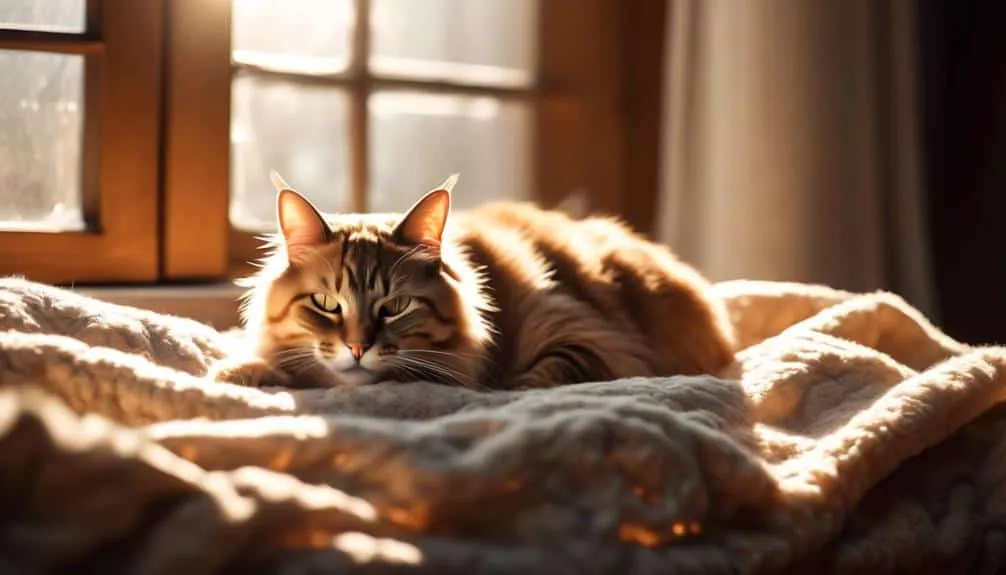The Best Fluffy Pancakes recipe you will fall in love with. Full of tips and tricks to help you make the best pancakes.

Have you ever wondered why cats have such a peculiar habit of kneading? Well, my fellow cat enthusiasts, it turns out that there's more to this behavior than meets the eye.
As we delve into the world of cat kneading, we'll uncover the fascinating reasons behind this instinctual behavior and explore the art of redirecting it. But here's the twist – punishment is not the answer.
So, if you're ready to learn effective techniques for managing and redirecting your cat's kneading tendencies, keep reading to discover the secrets to a harmonious relationship with your feline friend.
Key Takeaways
- Cat kneading is a natural behavior rooted in instincts and difficult to change.
- Punishing cats for kneading is ineffective, confusing, and can damage the human-feline bond.
- Managing excessive kneading can be done through trimming nails, using nail caps, and providing alternative surfaces for kneading.
- Redirecting kneading behavior with scratching posts, toys, and positive reinforcement can help cats knead in appropriate areas.
Reasons for Cat Kneading
Cat kneading is a natural and instinctual behavior that starts in kittenhood. This kneading behavior, also known as 'making biscuits,' involves the repeated pushing and pulling of their paws against a soft surface. Cats knead when they're happy, comfortable, and feeling secure. It's an instinctual behavior deeply rooted in their nature.
Kneading can serve multiple purposes for cats, such as marking territory or creating a comfortable bed. While it may be tempting to punish cats for this behavior, it's ineffective and can damage the human-feline bond. Understanding the reasons behind cat kneading allows us to redirect their behavior effectively.
Why Punishment Is Not Effective
Punishing cats for their kneading behavior is ineffective and can damage the bond between humans and felines. Cats' kneading behavior is instinctual and natural, making it difficult to change. Consequences of punishment can confuse cats and lead to negative associations. They may not associate punishment with kneading, causing the punishment to be ineffective.
Additionally, punishment can't be applied at all times, as cats may knead when their owners aren't present. Instead of punishment, it's important to understand cat behavior and find alternative ways to manage excessive kneading. This can include providing fleece blankets or comfortable bedding for cats to knead on, using scratching posts or pads to redirect their behavior, and offering toys or interactive play to distract them. Positive reinforcement can also be used to encourage cats to knead in appropriate areas.
Seeking professional help from a veterinarian or animal behaviorist may be necessary in some cases.
Managing Excessive Kneading
Instead of resorting to punishment, it's important to explore effective strategies for managing excessive kneading in cats.
Understanding instincts is key to addressing this behavior. One strategy is using positive reinforcement to encourage cats to knead in appropriate areas. Providing fleece blankets or comfortable bedding options can redirect their kneading behavior. Additionally, offering scratching posts or pads can provide an alternative for them to knead on.
Engaging cats in play with toys can also distract them from excessive kneading. Regular nail trimming is important to prevent damage, and nail caps can be used to protect furniture and skin. It's crucial to avoid declawing, as it isn't a recommended solution.
Seeking professional help from a veterinarian or animal behaviorist may be necessary in some cases. By employing these strategies, we can effectively manage excessive kneading in cats.
Redirecting Kneading Behavior
To redirect kneading behavior in cats, providing alternative surfaces for them to knead on can be effective. Cats naturally have the instinct to knead, so offering them alternative surfaces can help redirect this behavior away from furniture and other inappropriate areas.
One option is to provide fleece blankets or soft towels that they can knead on. Additionally, using scratching posts or pads can give cats a designated area for kneading. Interactive play or toys can also distract cats from kneading in unwanted places.
It's important to use positive reinforcement when redirecting their behavior, praising and rewarding them when they choose to knead on the appropriate surfaces. By providing alternative options and using positive reinforcement, we can encourage cats to engage in their kneading behavior in appropriate areas, preserving our furniture and creating a harmonious living environment.
Seeking Professional Help
When redirecting kneading behavior in cats, it's important to recognize that seeking professional help can be beneficial in addressing excessive kneading and related issues. Veterinary consultation is a valuable resource for understanding the underlying causes of the behavior and developing appropriate strategies. Behavior modification techniques, recommended by professionals, can help modify and redirect the cat's kneading behavior effectively.
Seeking advice from experienced cat owners or online communities is also helpful in gaining insights and practical tips. In some cases, medication or pheromone therapy may be recommended for cats with anxiety-related kneading. Remember, professional help should be considered when the behavior becomes problematic and affects the cat's well-being or the household's harmony.
Frequently Asked Questions
Are All Cats Prone to Kneading Behavior or Is It Specific to Certain Breeds?
All cats are prone to kneading behavior, regardless of breed. Genetic factors play a role in this instinctual behavior, but environmental factors can also influence kneading behavior in different cat breeds.
Can Kneading Behavior Be a Sign of Pain or Discomfort in Cats?
Understanding the psychology behind kneading behavior is key to determining if it's a sign of pain or discomfort in cats. Look for other pain indicators like vocalization, limping, or changes in appetite.
Is There a Certain Age at Which Cats Stop Kneading?
Kneading behavior in kittens typically starts in early kittenhood and can be encouraged by providing soft surfaces for them to knead on. Kneading is significant for cat communication and bonding, as it helps them mark territory and create a sense of comfort.
How Can I Determine if My Cat's Kneading Behavior Is Excessive?
To determine if your cat's kneading behavior is excessive, observe if it causes harm or disrupts daily life. If so, seek professional help. Redirecting excessive kneading can be done by providing alternative surfaces, using scratching posts, and offering interactive play.
Are There Any Alternative Methods to Redirecting Kneading Behavior Besides Providing Fleece Blankets or Scratching Posts?
There are various ways to redirect kneading behavior besides using blankets or scratching posts. Interactive toys and creative DIY solutions can provide alternative outlets for cats to satisfy their kneading instincts.
Conclusion
In conclusion, cat kneading is a delightful yet sometimes challenging behavior that requires our understanding and guidance. By debunking the myth of punishment and instead focusing on redirection, we can find a harmonious balance with our kneading companions.
From providing appropriate scratching surfaces to engaging in interactive play, we can channel their instincts in a positive way. And remember, seeking professional help is always an option if needed.
So let's embrace the art of redirecting and enjoy the love and warmth that comes with our kneading kitties!










